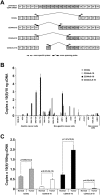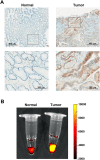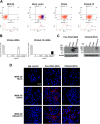CD44v8-10 as a potential theranostic biomarker for targeting disseminated cancer cells in advanced gastric cancer
- PMID: 28694503
- PMCID: PMC5503939
- DOI: 10.1038/s41598-017-05247-7
CD44v8-10 as a potential theranostic biomarker for targeting disseminated cancer cells in advanced gastric cancer
Abstract
Gastric cancer is the third most common cause of cancer mortality, and the survival rate of stage IV advanced gastric cancer (AGC) patients with distant metastasis is very low. Thus, the detection and eradication of disseminated cancer cells by targeting cell surface molecules in AGC would improve patient survival. The hyaluronic acid receptor, CD44, has various isoforms generated by alternative splicing, and some isoforms are known to be correlated to gastric cancer. In this study, to find out the most appropriate CD44v for targeting AGC, we analysed the expression differences of CD44 isoforms at the mRNA level in stomach cancer cell lines as well as in 74 patients with AGC by using exon-specific qRT-PCR. Among the CD44v isoforms, CD44v8-10 was determined as the most promising biomarker for the development of theranostic agents of gastric cancer. Next, we synthesised the conjugate of anti-CD44v9 antibody with near-infrared fluorophore or photosensitiser, and then demonstrated its feasibility for target cell-specific imaging and photoimmunotherapy in gastric cancer. As a result, these conjugates have clearly demarcated the surface of CD44v8-10 expressing cancer cells and showed efficient phototoxic effects. Therefore, this study revealed that CD44v8-10 is the efficient theranostic biomarker to target disseminated cancer cells in AGC.
Conflict of interest statement
The authors declare that they have no competing interests.
Figures





Similar articles
-
Variant isoforms of CD44 involves acquisition of chemoresistance to cisplatin and has potential as a novel indicator for identifying a cisplatin-resistant population in urothelial cancer.BMC Cancer. 2018 Jan 31;18(1):113. doi: 10.1186/s12885-018-3988-3. BMC Cancer. 2018. PMID: 29385995 Free PMC article.
-
Regulation of CD44v6 expression in gastric carcinoma by the IL-6/STAT3 signaling pathway and its clinical significance.Oncotarget. 2017 Jul 11;8(28):45848-45861. doi: 10.18632/oncotarget.17435. Oncotarget. 2017. PMID: 28507278 Free PMC article.
-
CD44 Splice Variant v8-10 as a Marker of Serous Ovarian Cancer Prognosis.PLoS One. 2016 Jun 2;11(6):e0156595. doi: 10.1371/journal.pone.0156595. eCollection 2016. PLoS One. 2016. PMID: 27253518 Free PMC article.
-
Concise Review: Emerging Role of CD44 in Cancer Stem Cells: A Promising Biomarker and Therapeutic Target.Stem Cells Transl Med. 2015 Sep;4(9):1033-43. doi: 10.5966/sctm.2015-0048. Epub 2015 Jul 1. Stem Cells Transl Med. 2015. PMID: 26136504 Free PMC article. Review.
-
Roles and targeting of the HAS/hyaluronan/CD44 molecular system in cancer.Matrix Biol. 2017 May;59:3-22. doi: 10.1016/j.matbio.2016.10.001. Epub 2016 Oct 13. Matrix Biol. 2017. PMID: 27746219 Review.
Cited by
-
CD44: A Multifunctional Mediator of Cancer Progression.Biomolecules. 2021 Dec 9;11(12):1850. doi: 10.3390/biom11121850. Biomolecules. 2021. PMID: 34944493 Free PMC article. Review.
-
Impact of Truncated O-glycans in Gastric-Cancer-Associated CD44v9 Detection.Cells. 2020 Jan 21;9(2):264. doi: 10.3390/cells9020264. Cells. 2020. PMID: 31973075 Free PMC article.
-
Advances in targeted therapy for human epidermal growth factor receptor 2 positive in advanced gastric cancer.World J Gastrointest Oncol. 2024 Jun 15;16(6):2318-2334. doi: 10.4251/wjgo.v16.i6.2318. World J Gastrointest Oncol. 2024. PMID: 38994153 Free PMC article. Review.
-
Alternative-splicing defects in cancer: Splicing regulators and their downstream targets, guiding the way to novel cancer therapeutics.Wiley Interdiscip Rev RNA. 2018 Jul;9(4):e1476. doi: 10.1002/wrna.1476. Epub 2018 Apr 25. Wiley Interdiscip Rev RNA. 2018. PMID: 29693319 Free PMC article. Review.
-
Diagnostic and prognostic value of CD44v9 and TIM3 expression in CK‑ and CK+ regions in gastric cancer tissues.Oncol Lett. 2024 Aug 6;28(4):479. doi: 10.3892/ol.2024.14612. eCollection 2024 Oct. Oncol Lett. 2024. PMID: 39161328 Free PMC article.
References
Publication types
MeSH terms
Substances
LinkOut - more resources
Full Text Sources
Other Literature Sources
Medical
Research Materials
Miscellaneous

